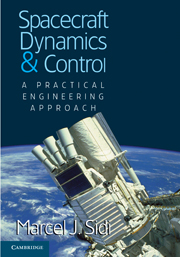Book contents
- Frontmatter
- Dedication
- Contents
- Preface
- Acknowledgments
- Chapter 1 Introduction
- Chapter 2 Orbit Dynamics
- Chapter 3 Orbital Maneuvers
- Chapter 4 Attitude Dynamics and Kinematics
- Chapter 5 Gravity Gradient Stabilization
- Chapter 6 Single- and Dual-Spin Stabilization
- Chapter 7 Attitude Maneuvers in Space
- Chapter 8 Momentum-Biased Attitude Stabilization
- Chapter 9 Reaction Thruster Attitude Control
- Chapter 10 Structural Dynamics and Liquid Sloshing
- Appendix A Attitude Transformations in Space
- Appendix B Attitude Determination Hardware
- Appendix C Orbit and Attitude Control Hardware
- Index
- References
Chapter 1 - Introduction
Published online by Cambridge University Press: 18 December 2014
- Frontmatter
- Dedication
- Contents
- Preface
- Acknowledgments
- Chapter 1 Introduction
- Chapter 2 Orbit Dynamics
- Chapter 3 Orbital Maneuvers
- Chapter 4 Attitude Dynamics and Kinematics
- Chapter 5 Gravity Gradient Stabilization
- Chapter 6 Single- and Dual-Spin Stabilization
- Chapter 7 Attitude Maneuvers in Space
- Chapter 8 Momentum-Biased Attitude Stabilization
- Chapter 9 Reaction Thruster Attitude Control
- Chapter 10 Structural Dynamics and Liquid Sloshing
- Appendix A Attitude Transformations in Space
- Appendix B Attitude Determination Hardware
- Appendix C Orbit and Attitude Control Hardware
- Index
- References
Summary
Overview
Space technology is relatively young compared to other modern technologies, such as aircraft technology. However, in only forty years this novel domain has achieved a tremendous level of complexity and sophistication. The reason for this is simply explained: most satellites, once in space, must rely heavily on the quality of their onboard instrumentation and on the design ingenuity of the scientists and engineers who produced them. Recent achievements of repairing satellites while in orbit testify to the complexity involved in space technology. The desire of humans to conquer space within the solar system will surely encourage new technological achievements that are not yet imagined.
The technical fields in which satellites are used are numerous – telecommunications, scientific research, meteorology, and others. According to the specific task for which they are designed, satellites are very different from one another. They may be in orbits as low as 200 km or as high as 40,000 km above the earth; other spacecraft leave the earth toward planets in the solar system. Satellites may be very heavy: an inhabited space station, for example, could weigh several tons or more. There also exist very light satellites, weighing 20 kg or less. Small satellites may be relatively cheap, of the order of a million dollars apiece. Despite their differences, satellites possess fundamental features that are common to all. The physical laws that govern their motion in space and their dynamics are the same for all spacecraft. Hence, the fundamental technologies that evolved from these laws are common to all.
A satellite's life begins with the specific booster transferring it to some initial orbit, called a transfer orbit, in which the satellite is already circling the earth. For a satellite that will stay near earth, the next stage will be to “ameliorate” the orbit; this means that the satellite must be maneuvered to reach the precise orbit for which the satellite was designed to fulfill its mission. Next, the satellite's software must check for the proper functioning of its instrumentation and its performance in space, as well as calibrate some of the instruments before they can be used to control the satellite. The final stage is the one for which the satellite was designed and manufactured.
- Type
- Chapter
- Information
- Spacecraft Dynamics and ControlA Practical Engineering Approach, pp. 1 - 7Publisher: Cambridge University PressPrint publication year: 1997



